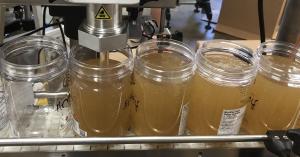Comparing the Health Benefits of Different Honeys
With increasing numbers of people eating honey for its health benefits, marketers scramble to claim health benefits specific to their honey.
Health-conscious consumers that eat honey to enjoy these health benefits may wonder if some kinds of honey are healthier than others. The intensive marketing by manuka honey retailers has convinced many that manuka honey is healthier than other kinds of honey. While manuka honey is uniquely good for making sterile wound dressings, good evidence that manuka honey is healthier to eat than other raw honeys is lacking.
Why is honey healthy?
Honey is produced when honeybees forage nectar from flower blossoms. (Honeydew honey is a rarer type of honey produced when bees foraging aphid secretions, but for simplicity this article will deal with blossom honey.) Honeybees bring nectar back to their hive and “work” it until it becomes mature honey. The bees dry the nectar to reduce the water content of the honey, modify some nectar components, and also add some enzymes of their own to the honey. Health benefits of honey are derived from the hundreds of different organic molecules present in honey in addition to fructose, glucose and water. While research has confirmed the health benefits of honey mentioned above, determining exactly which components of honey are responsible for any given health benefit is difficult.
What about the floral source?
Any honey connoisseur is familiar with the tremendous diversity of honey from different floral sources. Honey from one flower or another is often marketed as being “higher in antioxidants”, “best for sore throats”, or just healthier in general. Manuka honey is an excellent example of a honey perceived as especially healthy due its methylglyoxal (MGO) content. MGO is a heat-stable antibacterial molecule present in manuka honey but not found in other honeys. It is the MGO content that makes manuka honey so uniquely appropriate for making sterilized medical grade wound dressings. However, MGO, and the related UMF number, are essentially irrelevant when the honey is consumed orally. There is no evidence that MGO makes raw manuka honey any healthier to eat than any other raw honey. If you are eating the honey rather than making wound dressings, you can ignore the MGO and UMF numbers.
Similar situations exist with other kinds of honey that are known to contain compounds that have been linked to single beneficial properties, like buckwheat honey and antioxidants. One study shows that buckwheat honey has high anti-oxidant properties as measured by total phenolic activity (while other types of honey exhibit greater anti-oxidant activity by other measurement methods). Of all the health benefits mentioned above, buckwheat honey may have higher activity in one sub-category of one health benefit – hardly evidence that “buckwheat honey is healthier than other honeys”. The same study showed buckwheat pollen accounted for only 28.8 to 35.5% of the total pollen of buckwheat honey: Actual buckwheat honey comprises only a small fraction of honey labelled “buckwheat honey”.
The problem with heat
Organic molecules tend to break down over time in a temperature-dependent manner. Honey gradually loses its healthy properties as its organic compounds denature over time. This likely explains why, in Chinese culture, people prefer to eat the freshest honey available. At room temperature honey ageing happens gradually, with measurable decreases in specific beneficial compounds occurring over weeks, months, or even years.
When honey is intentionally heated to higher temperatures, the organic molecules break down much more rapidly which explains why raw honey is healthier for you than pasteurized honey: the pasteurization process destroys a lot of the organic substances that make honey healthy. Ultrafiltering (that usually accompanies pasteurization) further removes healthy proteins, vitamins and minerals present in pollen and propolis.
Is there a number that quantifies the “healthiness” of honey?
Short answer – no. But, since fresh raw honey has the most intact naturally healthy organic compounds, the fresher the honey is, the healthier it is to eat. Hydroxymethylfurfural (HMF) is an organic compound that is not present in fresh honey, but forms over time as honey is exposed to heat. The warmer the honey is, the faster HMF forms, making HMF content a reliable indicator of “raw-ness” of honey. HMF content below 15mg indicates honey that has been exposed to neither significant heating nor long term storage at lower ambient temperatures.
Sweetwater Science Labs in Columbia, Missouri is one of the leading authenticity and testing laboratories for honey in the USA. Dr. James Gawenis, the Chief Chemist at Sweetwater Science Labs, points out in Canada and USA, the term “raw honey” lacks a specific government definition. He prefers to use the term “freshness” for honey. Dr. Gawenis agrees that “The single best indicator of honey freshness is HMF content. I would add a second test, diastase activity, to determine whether an elevated HMF is due to intentionally heating the honey, or to honey that has been stored for longer times at ambient temperatures.”
Honey is best thought of as one part of a healthy diet and lifestyle rather than as a miraculous natural cure for any specific clinical illness. While there is increasing evidence that eating raw honey rather than processed sugars provides numerous health benefits over the long term, there is no clear evidence that eating any variety of honey provides more health benefits than eating any other variety of honey. Whatever your favorite raw honey is, it’s as good for you as any other honey.
Jeremy Wendell
Wendell Estate Honey
+1 204-564-2599
email us here
The journey of honey from beehive to jar at Wendell Honey Farm
Legal Disclaimer:
EIN Presswire provides this news content "as is" without warranty of any kind. We do not accept any responsibility or liability for the accuracy, content, images, videos, licenses, completeness, legality, or reliability of the information contained in this article. If you have any complaints or copyright issues related to this article, kindly contact the author above.


